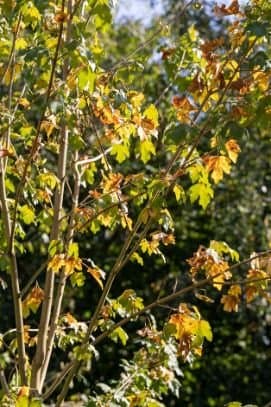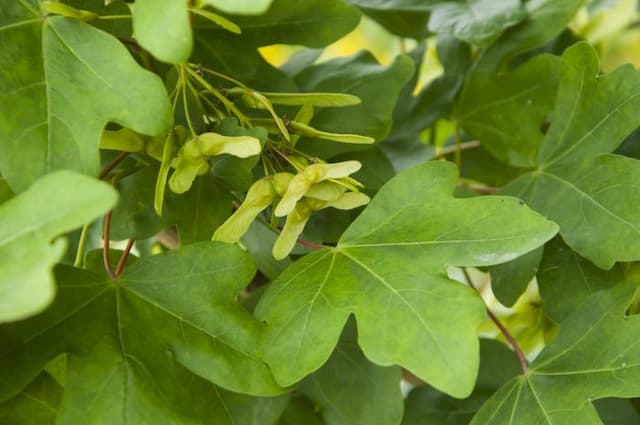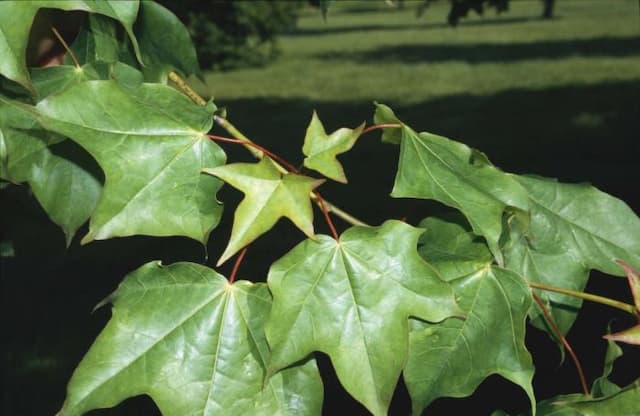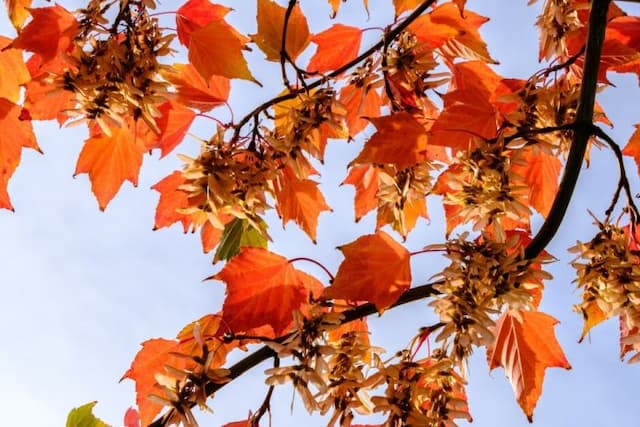Japanese Maple Acer palmatum 'Aureum' (P)

ABOUT
The Japanese maple 'Aureum' is a visually striking plant known for its ornamental qualities and its foliage which varies in color throughout the seasons. The leaves of this plant are palmate, which means they resemble an open hand with fingers spreading out, and they have a delicate structure with multiple lobes, often five to nine in total. During the spring and early summer, the leaves display a vibrant golden-yellow color, which can create a striking contrast with the darker greens in a garden landscape. As the seasons progress, the foliage may transition to a greenish color with shades of gold still present, maintaining its unique appeal even as the colors shift. The edges of the leaves are finely serrated or toothed, providing additional texture to the plant's appearance. In the fall, the Japanese maple 'Aureum' transforms once again, offering a stunning display of colors ranging from bright yellow to orange and even red, adding to the plant's multi-season interest. The tree's overall form is elegant, with a graceful branching pattern that can be appreciated especially in the winter months when the leaves have fallen and the structural interest of the bare branches comes to the foreground. Delicate flowers may also appear in spring, although less noticeable compared to the foliage, they add an extra layer of interest to the plant. The bark of the Japanese maple 'Aureum' is smooth and may have a subtle color that complements the foliage, often remaining unobtrusive, allowing the leaves to be the main focus. This Japanese maple cultivar is a favorite among gardeners and landscapers for its striking leaf color and the elegant, cascading form which makes it a beautiful centerpiece in any ornamental garden setting.
About this plant
 Names
NamesFamily
Sapindaceae
Synonyms
Golden Japanese Maple, Aureum Japanese Maple
Common names
Acer palmatum 'Aureum'
 Toxicity
ToxicityTo humans
The Japanese maple is generally considered to be non-toxic to humans. There are no significant reports of poisoning from ingesting any part of the Acer palmatum 'Aureum' in humans, and it is not listed as a poisonous plant. Therefore, ingestion is unlikely to cause any symptoms of poisoning or have serious consequences.
To pets
The Japanese maple is also generally considered to be non-toxic to pets. There is no significant evidence to suggest that ingestion of Acer palmatum 'Aureum' parts by pets, such as dogs or cats, will lead to poisoning or result in adverse health effects. Consequently, symptoms of toxicity following ingestion are not expected to occur in pets.
 Characteristics
CharacteristicsLife cycle
Perennials
Foliage type
Deciduous
Color of leaves
Yellow
Height
15-25 feet (4.5-7.6 meters)
Spread
15-25 feet (4.5-7.6 meters)
Plant type
Tree
Hardiness zones
5-8
Native area
Japan
Benefits
 General Benefits
General Benefits- Ornamental Value: The Acer palmatum 'Aureum', commonly known as Golden Japanese Maple, offers stunning visual appeal with its unique golden-yellow leaves, especially striking in the spring and fall.
- Landscaping Versatility: This plant can be used in a variety of landscape settings, including as a focal point, in mixed borders, or in Japanese garden designs.
- Shade Tolerance: Golden Japanese Maple can grow well in partial shade, making it a good choice for under-canopy planting and shaded garden areas.
- Seasonal Interest: With its changing leaf colors through the seasons, from bright golden in spring to greenish in summer and golden-orange to red in autumn, it provides year-round interest.
- Compact Size: This cultivar generally remains relatively small, making it suitable for gardens with limited space and for container growing.
- Habitat for Wildlife: Its dense foliage offers shelter and its winged seeds serve as food for various bird species, thus supporting local biodiversity.
- Low Maintenance: Once established, Acer palmatum 'Aureum' requires minimal maintenance, making it a convenient choice for busy gardeners.
- Cultural Significance: It has a special place in Japanese culture and gardening, adding cultural depth and educational interest to a garden.
- Drought Resistance: After establishment, it exhibits some drought tolerance, reducing the need for frequent watering during dry periods.
- Fall Foliage: The dramatic color changes in autumn make it a popular choice for creating stunning fall landscapes and for use in seasonal displays.
 Medical Properties
Medical PropertiesThis plant is not used for medical purposes.
 Air-purifying Qualities
Air-purifying QualitiesThis plant is not specifically known for air purifying qualities.
 Other Uses
Other Uses- Japanese maple leaves can be pressed and used in scrapbooking or as a natural art medium to create elegant patterns or designs for decorative purposes.
- The wood from Acer palmatum 'Aureum' is sometimes used to make small woodworking projects, such as boxes or picture frames, owing to its fine grain and color.
- Dried branches of the Japanese maple can be incorporated into flower arrangements or wreaths for an added natural and artistic touch.
- Young saplings of Acer palmatum 'Aureum' can be trained into bonsai forms, making them a centerpiece in miniature gardening and bonsai art.
- Leaves of the Japanese maple are sometimes used in educational settings for leaf structure studies due to their unique palmate shape.
- During the autumn, the fallen leaves of Acer palmatum 'Aureum' can be collected and used as a natural dye for fabrics, providing shades of yellow and orange.
- The bark of the tree can be used as a textural element in landscape photography, highlighting the contrast between the delicate leaves and rougher bark.
- Japanese maple trees can serve as habitat and support for birdhouses, encouraging avian biodiversity in gardens and urban environments.
- Acer palmatum 'Aureum' can be used as a natural screen or divider in gardens due to its dense foliage and branching structure.
- The structure and form of the Japanese maple are often studied by artists and designers seeking inspiration for patterns, sculptures, or architectural elements.
Interesting Facts
 Feng Shui
Feng ShuiThe Japanese Maple is not used in Feng Shui practice.
 Zodiac Sign Compitability
Zodiac Sign CompitabilityThe Japanese Maple is not used in astrology practice.
 Plant Symbolism
Plant Symbolism- Peace and Serenity: The Japanese Maple, known for its calming presence in gardens, is often associated with peace and serenity, reflecting a tranquil and meditative environment.
- Balan ce and Harmony: With its balanced and symmetrical growth pattern, the Japanese Maple symbolizes harmony in nature, emphasizing a sense of equilibrium in life.
- Endurance and Patience: As a plant that experiences and endures the changing seasons, the Japanese Maple represents the virtues of endurance and patience, adapting to and withstanding various conditions.
- Grace and Elegance: With its delicate leaves and elegant branching, the Japanese Maple is often seen as a symbol of grace and aesthetic beauty, embodying finesse and sophistication.
- Change and Transformation: As a plant with leaves that change color dramatically with the seasons, the Japanese Maple signifies change and transformation, reminding one of the ever-evolving nature of life.
 Water
WaterJapanese Maples, including the 'Aureum' variety, prefer consistent moisture but do not cope well with oversaturation. They should be watered deeply and thoroughly when the top inch of soil feels dry to the touch, which often translates to approximately once a week during typical weather conditions. During periods of drought or extreme heat, more frequent watering may be necessary. A good rule of thumb for an established tree is to provide it with roughly 10 gallons of water per week, adjusting as needed based on weather. Less water will be required during cooler months, and it's crucial to ensure the soil has good drainage to prevent root rot.
 Light
LightJapanese Maples thrive in partial shade, especially the 'Aureum' which requires protection from intense afternoon sun to prevent leaf scorch. The ideal location would offer morning sunlight with dappled or filtered shade in the afternoon. A spot that mimics the light conditions of a forest understory with bright, indirect light is optimal for encouraging the vibrant foliage color while protecting the leaves.
 Temperature
TemperatureThe 'Aureum' Japanese Maple performs best in temperate climates and can handle temperatures ranging from roughly 15°F in the winter to 90°F in the summer. Freezing temperatures below this range can damage the tree, and excess heat may cause stress. The ideal temperature range for thriving growth is between 60°F and 80°F. This plant appreciates a slightly cooler climate and may require extra care in regions with hot summers.
 Pruning
PruningThe 'Aureum' Japanese Maple should be pruned to maintain its natural shape, remove any dead or diseased branches, and encourage healthy growth. Pruning is best done in the late winter or early spring while the tree is still dormant and before the sap starts to flow. Light pruning may also be done in mid-summer if needed. It is often unnecessary to prune annually; a careful pruning every few years is typically sufficient.
 Cleaning
CleaningAs needed
 Soil
SoilThe Golden Japanese Maple prefers well-draining, consistently moist soil with an acidic to neutral pH around 5.5 to 7.0. An ideal soil mix might include one part peat moss, one part pine bark, and one part coarse sand to ensure proper drainage and aeration.
 Repotting
RepottingGolden Japanese Maples should be repotted every 2 to 3 years to refresh the soil and encourage a healthy root system. Young, actively growing trees may benefit from more frequent repotting.
 Humidity & Misting
Humidity & MistingGolden Japanese Maples thrive in average outdoor humidity levels. They handle humidity variations well, but do not require high humidity environments specifically.
 Suitable locations
Suitable locationsIndoor
Place in bright, indirect light with some direct morning sun.
Outdoor
Choose part-shade location, shelter from strong winds.
Hardiness zone
5-8 USDA
 Life cycle
Life cycleThe life cycle of the Japanese Maple 'Aureum' begins with seed germination, which requires stratification to break dormancy, usually occurring in the spring following a winter period. The seedlings then establish a taproot and begin to produce distinctive lobed leaves as they enter the juvenile phase, growing rapidly in favorable conditions with adequate moisture and partial shade. As the tree matures, it develops a woody trunk and branches, reaching its characteristic size and form within several years; this mature phase can last for many decades, with the tree producing seeds annually once it reaches reproductive maturity. Throughout its life, the Japanese Maple 'Aureum' experiences an annual cycle of growth, with leaves budding in spring, flourishing through the summer, and then changing to vibrant golds and yellows in the autumn before shedding. In winter, the tree enters dormancy, conserving energy until the next growth cycle begins. With proper care and in the absence of disease or severe environmental stress, the Japanese Maple 'Aureum' can live for over a century, contributing to its landscape with seasonal beauty year after year.
 Propogation
PropogationPropogation time
Spring-Early Summer
The Japanese Maple 'Aureum' can be propagated through a variety of methods but the most popular technique is by softwood cuttings. This procedure is best performed in the early summer when new growth is still flexible. Gardeners should select a healthy stem that has new growth, and cut a 4 to 6-inch (10 to 15 centimeters) section just below a leaf node. The leaves at the bottom half of the stem should be removed and the cut end can be dipped in rooting hormone powder to encourage root development, though this step is not mandatory. The cutting should then be placed in a pot with a mix of peat and perlite, ensuring that the leaf nodes where the leaves were removed are buried. The container needs to be kept in a warm and humid environment, ideally under a plastic cover, and the soil should be consistently moist but not waterlogged. Roots usually develop within a few weeks, after which the cutting can be transplanted into a larger pot or directly into the garden.









